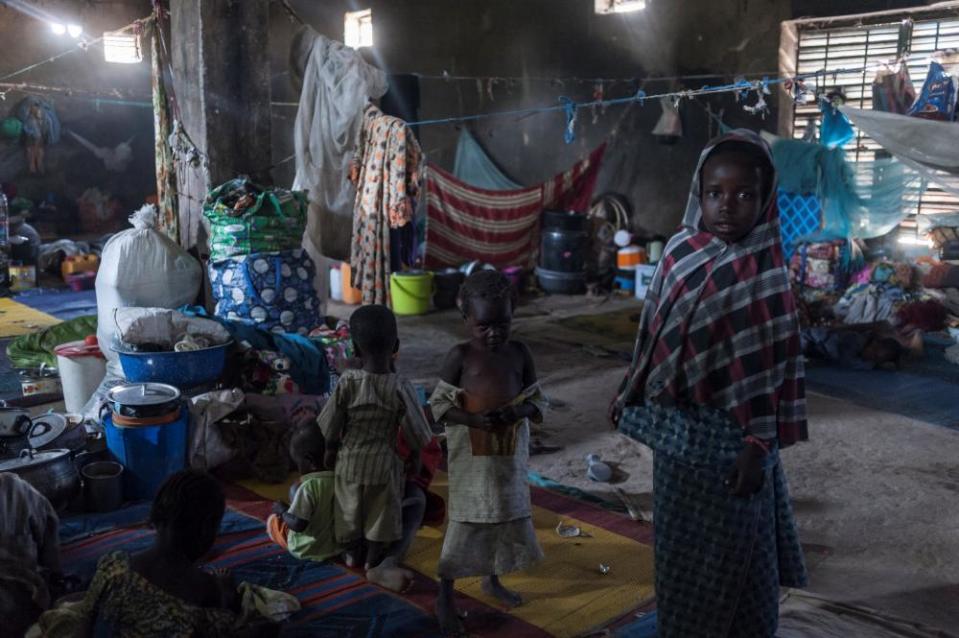Famine threatens lives of nearly half a million Nigerian children, says Unicef

Hundreds of thousands of children under the age of five in north-eastern Nigeria will suffer from severe acute malnutrition this year, with up to 20% dying unless more is done to reach them, according to the UN children’s fund, Unicef, and other aid organisations.
The estimated number of affected children is now 450,000 (pdf), with 14 million people needing humanitarian assistance across the region.
Nigeria is one of four countries the UN has warned is facing famine, along with Somalia, Yemen and South Sudan, where famine was declared on Monday in parts of the country.
On Friday, a major international conference, hosted by Nigeria, Norway and Germany, will be held in Oslo aimed at increasing funding for the crisis in north-east Nigeria and the wider Lake Chad region.
Nigeria’s north-east has for decades been poor, underdeveloped and dominated by agricultural industry and subsistence farming. In the past four years, the insurgency by Boko Haram has exacerbated problems in the region, leaving it further impoverished and facing a severe lack of food.
The insecurity has left many farmers unable to plant or harvest their crops. In Borno state, 5.8 million people face extreme food and nutrition deficits, a figure that has doubled in the past year.
According to Doune Porter, chief of communication for Unicef in Nigeria, the international community has failed to grasp the seriousness of the need for financial support in the region. “Last year we had a funding appeal of $115m [£92.4m] but we received just 41%,” he said. “We’ve still managed to do what we can. In the final eight weeks of last year we were able to scale up our aid by 37%. It’s made an impact, but without increased funding these are fragile gains.”
When humanitarian workers are able to access insecure areas, helping children suffering from severe acute malnutrition is straightforward, according to Porter. “Treating them is a simple eight-week out-patient process that is really effective in helping develop their diet and health.”
Around 1.8 million people are internally displaced with most living in accommodating – but increasingly populated – host communities. In the heat, some mothers feed water to their babies below the age of six months, which has increased malnutrition, especially in areas where water purity is low. Porter said that campaigns have been very effective in explaining to women that feeding infants exclusively with breast milk is the best way to prevent malnutrition.

But aid organisations face challenges in reaching the areas most in need. “When we get there, the rates of malnutrition drop significantly,” Porter said. “The problem we have is reaching those areas that are still inaccessible due to the insecurity.”
Last year, the Nigerian government and army announced they had “technically won the war” against Boko Haram, after President Muhammadu Buhari set a December deadline for defeating the terrorist group. Many areas in Borno state have indeed been liberated from Boko Haram occupation after a concerted military effort. Yet many of these areas are still dangerous and remain under military control, with residents’ movement restricted.
According to the Office for the Coordination of Humanitarian Affairs, Ocha, about a third of Borno remains inaccessible due to insecurity.
Adrian Ouvry, the regional humanitarian adviser for Mercy Corps, said that many areas deemed safe by the military remain under tight control. “In some areas, like Dikwa in eastern Borno, there are over 110,000 people penned into a heavily guarded urban area because of the surrounding insecurity.”
He spoke of some areas having improved, mentioning Damboa in central Borno, where six months ago he had witnessed many children whose hair had been turned red by severe malnutrition – he said instances are fewer now. But he warned against complacency. “The conditions that caused the crisis are still there, so even after malnutrition rates and death rates fall there is still a need to sustain resources to those areas.”
According to Unicef, of the 649 health centres and hospitals in Borno, 272 have been destroyed by the insurgency (pdf), putting added pressure on a state with millions in need of medical attention. The Nigerian government has been working with aid organisations to rebuild much of the health infrastructure in Borno.

Education in the region has also been severely disrupted. Alkasim Abdulkadir is head of communications for an initiative set up by President Buhari to coordinate government resources. He said that though the majority of primary and secondary schools in Borno have been destroyed, there has been some progress in reconstructing them. “In Chibok, the school where the Chibok girls were kidnapped has been levelled and is now being rebuilt, along with many other schools.”
The military have been demining farms across the state. According to Abdulkadir, much of the farmland had been a battlefield in the war against Boko Haram but the government is working to make it safe for cultivation again.
Yet while the military works to make liberated areas secure, conflict still poses a threat to the relief effort. A refugee camp in Rann, Borno, was inadvertently bombed in January by the Nigerian military, killing more than 100 displaced people and aid workers. In an incident two weeks previously, 30 people were killed by the army as the result of a communications error.
In neighbouring states such as Adamawa, aid organisations and the government have made significant progress in rebuilding destroyed areas and helping displaced people to resettle in safety. Yet across the north-east, and especially in Borno, the crisis remains. While some areas close to main trade routes have seen increased market activity and a decrease in malnutrition rates, maintaining and improving those conditions is a big challenge.

 Yahoo News
Yahoo News 
